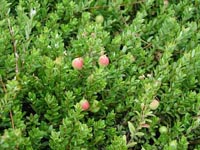Resource Library
Plant of the Week: Cranberry
The University of Arkansas System Division of Agriculture does not promote, support or recommend plants featured in "Plant of the Week." Please consult your local Extension office for plants suitable for your region.
Plant of the Week
Cranberry
Latin: Vaccinium macrocarpo

While on my Canadian tour in the summer, I had the opportunity to visit the Cranberry Capitol of Canada in Bala, Ontario.
As with many self-proclaimed "capitols," it was a fairly modest affair with only one grower. But, it was pretty far north and the farm was in a tourist area that celebrated "Cranberry Days," so it all made sense - especially to the Chamber of Commerce. As this was my first visit to a cranberry bog, I had to check it out.
Cranberries (Vaccinium macrocarpon) are trailing, mat forming, evergreen shrubs that belong to the azalea family and are closely related to blueberries. They grow naturally in peaty bogs in the northeastern states and adjacent areas of Canada.
The trailing stems may be a yard or more long but fruiting is primarily on short, foot-long side branches that are crowded with the small half-inch long shiny leaves. The four-parted pinkish blooms appear in June and are borne on a long, gracefully bent peduncle that resembles the neck of a crane, hence the name cranberry.
The marble-size red, sour berries begin ripening in September and October. Traditionally, harvesting was from wild bogs using a hand scoop. But today, cranberries are grown in manmade bogs, not unlike shallow catfish ponds, with harvest done by various types of mechanized strippers and beaters.
For berries destined for the fresh market - only about 5 percent of the cranberry harvest - mechanical strippers that comb the berries from the vines are used. For processed berries the bogs are flooded and harvested using floating beaters that knock the fruit from the vine. The berries are then herded to a floating line where they congregate in a sea of red.
To protect the plants during winter, bogs are flooded where they freeze into a solid block of ice. Then every couple winters they drive across the ice and scatter an inch of sand to keep the vines growing vigorously.
Cranberries have been grown commercially since the 1850s and are an important crop in Wisconsin and several New England states. Wisconsin has about 13,600 acres of cranberry bogs and produces about $75 million of fruit each year, the majority of which is sold through the Ocean Spray marketing cooperative.
In the early 1990s, the medical community began to better understand the role of diet in disease prevention and a new class of compounds, collectively called phytoceuticals, began to be discussed. Cranberries, and especially juiced cranberries, were high on the list of foods known to elicit positive dietary effect on disease development.
Proanthocyanidins found in the fruit prevent bacteria adhesion to tissue and are known to reduce urinary tract infection and reduce bacterial gum disease. Then medicine discovered antioxidants and their role in protecting cells from damage. Of 19 commonly consumed fruits, cranberries had the highest level of antioxidants.
Cranberry farming is controlled by a market order, meaning that farmers can grow as many acres as they wish, but they can only sell a prescribed amount of fruit. With the good news from the medical community, Ocean Spray launched a marketing deal with one the big soft drink bottlers to distribute cranberry juice and a lot of new cranberry bogs were planted.
But, as often happens, the increased production got dramatically ahead of consumption. The expanded line of cranberry juice drinks hit the marketplace at the same time as the other new healthy drink of the 90s, bottled water. We all know which beverage won that competition.
Suddenly, cranberry prices fell from about 60 cents a pound to 18 cents, and farmers began to look for villains to blame. They didn’t have to look far when they found that the executives at Ocean Spray were splitting millions of dollars of annual bonuses while many growers were on the brink of financial disaster. Such is the life of the farmer.
By: Gerald Klingaman, retired
Extension Horticulturist - Ornamentals
Extension News - November 28, 2003
The University of Arkansas System Division of Agriculture does not maintain lists of retail outlets where these plants can be purchased. Please check your local nursery or other retail outlets to ask about the availability of these plants for your growing area.